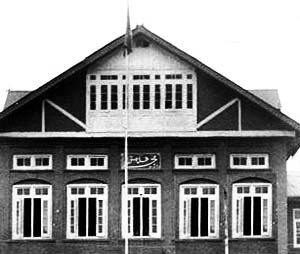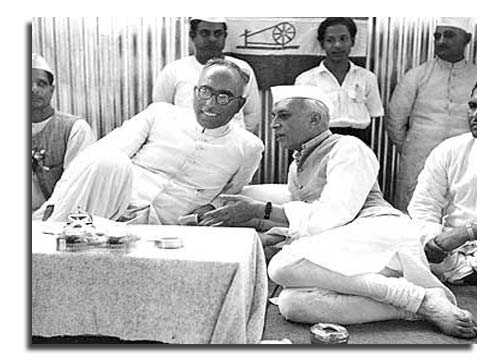Once a monument of resistance against Dogra regime, Mujahid Manzil was soon taken over by National Conference. As Kashmir erupted against Indian rule in early 90’s, the structure was set ablaze and is now lying in ruins and occupied by paramilitary forces. Bilal Handoo traces the past of a historic building which shaped the discourse of resistance politics in Kashmir.
In Srinagar’s Zaina Kadal, a seven-decade-old monument of resistance politics in Kashmir valley is lying in ruins. Situated adjacent to the Mughal marvel, Pather Masjid, which was built by Noor Jehan, the wife of the Mughal king, Jehangir, half-burnt wooden pillars and smoked walls are the only remains of Mujahid Manzil, which was once a hub for political activists fighting against the Dogra regime.
As Dogras continued to rule the Kashmir valley with an iron fist and resentment against them increased manifold, it was in 1933 that Moulana Masoodi and Sheikh Abdullah accompanied by other political activists went door-to-door and collected funds to build Mujahid Manzil. With Rs 2300, Mujahid Manzil or the ‘House of Mujahids’ came into existence in 1933. It soon became a political bastion of Muslim Conference with Saleh Khan appointed as its custodian and Moulana Masoodi as its supervisor.
“Once it came into existence, common Kashmiri who was bearing the brunt of Dogra oppression, suddenly found a platform to raise his voice against the slavery he was subjected to at that point of time,” Zareef Ahmad Zareef, a social activist, who has witnessed many historical events at the place, told Kashmir Life.
Zareef says this period saw political upheaval against the vicious rule of Maharaja Hari Singh, “At that significant moment, unending political activities at Mujahid Manzil created a mass awareness among slavery-ridden people and made them vocal against oppressive rule.”
As the popular support for the political activists at Mujahid Manzil grew across Kashmir valley, Muslim Conference suddenly donned secular garments and changed its name to National Conference (NC) in 1938. The move, Zareef says, disappointed a large number of die-hard supporters of the movement against Dogra slavery. “One of the prime faces was Sofi Mohammad Akbar who later played a pivotal force in all the pro-freedom activities of Plebiscite Front launched from the headquarters of Mujahid Manzil.”
Sofi served in Plebiscite Front till 1975 when Sheikh Mohammad Abdullah entered into the agreement known as “Indra-Abdullah Accord” and was installed as Chief Minister of J&K. “When Sheikh Mohammad Abdullah dissolved J&K Plebiscite Front in 1975, Sofi Mohammad Akbar didn’t accept that self-centred decision of Abdullah and left Mujahid Manzil to start his activities from his native hometown, Sopore,” Zareef says.
But Mujahid Manzil continued to remain the epicentre of Kashmiri political activities and it was from here that the people of Jammu and Kashmir fought against autocratic rule in 1940. After 1947, when the Indian subcontinent was divided, it became the abode of Sheikh Abdullah till his death.
“Hurriyat leader like Syed Ali Geelani and Jamiat leader Qari Saif-u-Din too sung songs of freedom in unison here along with Sheikh Abdullah, Chowdary Ghulam Abbas and Mirwaiz Yusuf Shah,” Abdul Rahim, an old shopkeeper near Pather Masjid, who has witnessed six decades of activities at Mujahid Manzil, said.
Rahim, a resident of Nawab Bazar in the old city, has been selling jute bags at his shop. Having lived close to Mujahid Manzil, he has vivid memories of some of the major events which took place there. As I talked to him, few old men at his shop joined the conversation, “When Pakistan came into existence in 1947, Pakistani national flag was unfurled here for some time,” one of them quipped.
While it remained the hotbed of Kashmir politics for around seven decades, Mujahid Manzil also served as the headquarters of NC till 1994 when the structure was set ablaze by suspected militants, forcing the NC to shift its headquarters to Nawai Subah complex in the secured uptown area.
“The place has for long been the sole repository of Kashmiri aspirations. This was where Mohammed Ali Jinnah came before the partition to seek Kashmir’s merger with Pakistan,” Rajab Bhat, a grocer, whose archaic wooden shop is situated close to the destroyed structure of Mujahid Manzil, said. Nehru also came here after Jinnah to convince Sheikh that his destiny lay with India, he says.
Now forgotten and occupied by paramilitary forces, the hollow structure of Mujahid Manzil was where Sheikh once opposed Pakistan, called for democracy in Kashmiri and subsequently brought Kashmir into the national mainstream. “This is where Farooq Abdullah came to protest against New Delhi’s excesses, against his toppling in 1984,” Rajab says.
 Plebiscite Front Movement was also hosted and led from Mujahid Manzil under the leadership of Sheikh Abdullah. But the place faced closure during former Chief Minister, Ghulam Muhammad Sadiq’s rule in early 70’s. “At that time, my father, Sadar-ud-Din Mujahid, was the custodian of the place,” says Shabir Mujahid, deputy director Jammu, Doordarshan. “He was once called in the midnight by a police party and asked to open the doors of Mujahid Manzil which he refused. Later, he was arrested like other leaders associated with the front. It was under Sadiq’s rule in the state that a ban was ordered on Plebiscite Front,” he says.
Plebiscite Front Movement was also hosted and led from Mujahid Manzil under the leadership of Sheikh Abdullah. But the place faced closure during former Chief Minister, Ghulam Muhammad Sadiq’s rule in early 70’s. “At that time, my father, Sadar-ud-Din Mujahid, was the custodian of the place,” says Shabir Mujahid, deputy director Jammu, Doordarshan. “He was once called in the midnight by a police party and asked to open the doors of Mujahid Manzil which he refused. Later, he was arrested like other leaders associated with the front. It was under Sadiq’s rule in the state that a ban was ordered on Plebiscite Front,” he says.
As the cries for armed rebellion against Indian rule got shriller during early 90’s, Mujahid Manzil became a prime target for the people who were seeking freedom from Indian rule and had lost faith in National Conference. “The three-storied stone and timber structure died with the peace of Kashmir, and important letters, documents and photographs of a contentious phase of Kashmiri history were lost,” says Zareef, adding, “The blaze also reduced the personal belongings of some of Kashmir’s great leaders to ashes as well like the desk where Sheikh sat and the chair which was once used by Nehru.” The building also hosted the iconic Indian political figures like Mahatma Gandhi on August 2, 1947, besides Maulana Abul Kalam Azad, Abdul Gaffar Khan and other front-ranking national leaders.
In 2005, during People’s Democratic Party-led coalition government in Jammu and Kashmir, a drama unfolded over the stakes of Mujahid Manzil. While the J&K Waqf Board said their record books showed that the building was their property, the PDP-led coalition government demanded its control, stating it was the property of the people of J&K. “We warn the Mufti government that it is not the property of any Maharaja but it is the castle of the identity of Kashmiris,” the NC had stated, adding, “Nobody can stop us from securing its every brick.”
 While hinting to revive the structure, Farooq Abdullah told the meeting at party headquarters at Nawai Subah last year: “There is a need to strengthen the roots of the party. It is time to revive our political headquarter, Mujahid Manzil.”
While hinting to revive the structure, Farooq Abdullah told the meeting at party headquarters at Nawai Subah last year: “There is a need to strengthen the roots of the party. It is time to revive our political headquarter, Mujahid Manzil.”
Mujahid Manzil has been the cradle of NC’s politics since its foundation. Right from Sheikh Abdullah led ‘Quit Kashmir’ movement against the Dogra Maharaja to the launch of Plebiscite Front to the demands of the right to self-determination by the people of Kashmir, Mujahid Manzil has always played a warm host. The annual July 13 procession on Martyrs Day commemorating the martyrs of 1931 was taken out by National Conference from Mujahid Manzil but the trend was shelved after the party shifted its headquarters.
“My father, Late Sheikh Muhammad Abdullah, used to listen to the grievances of the people at Mujahid Manzil after every Friday prayers. I want to revive the process,” Farooq told media last year. Apart from local people, both the mainstream and pro-freedom leaders regard this place in high esteem. Senior Hurriyat leader, Syed Ali Shah Geelani, once termed Mujahid Manzil as ‘a legacy of Kashmiri Martyrs’. However, after Sheikh Abdullah signed Delhi accord in 1975, there was a division in the political leadership following which many people here say that NC lost the moral authority to own the place.
The complex remained closed for 12 years before it was opened again in 2002. During the Governor’s rule in early 90’s, militants operated from Mujahid Manzil for some time. It was taken over by the security forces under provisions of the Armed Forces Special Powers Act and is now occupied by CRPF. The years of neglect have taken a toll on the building which is lying in ruins.
On July this year, Sheikh’s grandson, Omar Abdullah, expressed his will to restore the historic Mujahid Manzil and make it a heritage site. “It is my wish that we have Friday meetings again at Mujahid Manzil where Sheikh Sahib initiated this culture into our party,” Omar said, addressing party workers of Srinagar district.
Good luck!

















Good copy. There are a few repetitions. Copies like this should ideally have better photographs. Names of some of the Kashmir veterans need to be corrected like that of Choudhary ghulam Abbas